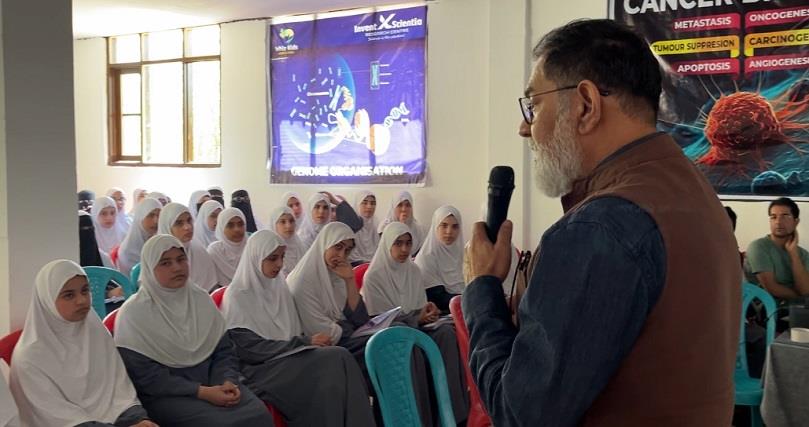
One Professor's Mission To Rethink Kashmir's Education
Prof Anunya Chaubey at Anantnag
There was a time, not too long ago, when asking questions in a classroom in Kashmir felt almost sinful. I remember my own school days clearly: critical thinking was unwelcome, curiosity was met with reprimand. Today, thankfully, the landscape is shifting. The National Education Policy (NEP) 2020 puts critical thinking at the heart of learning. But policies are only words unless they find meaning in the classroom - and that's where design thinking comes in.
My own understanding of this began in 2020, when I joined the Anant Fellowship for Climate Action. It was a transformative experience. I had long been working on environmental activism, but this fellowship added a rich academic layer to my work. It made me realise how deeply intertwined design thinking is with activism, education, and public policy.
Since then, I've been fortunate to witness something remarkable. Prof Anunaya Chaubey, Provost of Anant National University in Ahmedabad, has made it a mission to reach out to Kashmiri students, engaging them in conversations about sustainability, innovation, and design.
When Prof Chaubey visited National Innovations Public School (NIPS) in Shopian last year, I watched the students react in disbelief as he spoke about the hazards of pesticides. In a region known for apple production, the use of chemical fertilisers has long been normalised. But for these students, it was a moment of awakening. They wanted to know: What are the alternatives? What can we do?
A similar energy filled the room during his session at Birla Open Minds School in Pampore. Design thinking, as a concept, was new to them - but it resonated deeply. It wasn't abstract theory. It was a tool to understand, analyse, and solve the problems they live with every day.
Read Also Anant National University Ahmedabad Reaches Out To School Students In Kashmir Anantnag's Ace Educator Who Moved GenerationsIn January this year, Anant University hosted 35 students from three Kashmiri schools at their Ahmedabad campus in a programme charmingly titled Winter Is Cool. It was more than an academic trip. It was an immersion into a way of thinking that encourages empathy and solutions rooted in lived experience. Artists like Rayees Wathori helped anchor the programme, making it interactive and inspiring.
Prof Chaubey returned to Kashmir this April, and I joined him in workshops from Pampore to Bijbehara. At NIPS Shopian, students discussed ways to reduce pesticide use and pollution in Dal Lake. At Whizkids School in Anantnag and Government Boys Higher Secondary School Bijbehara, the conversations deepened. We weren't lecturing - we were listening. That's what design thinking demands: listen, empathise, act.
But such efforts face barriers - especially in government schools. In the last five years, these institutions have grown increasingly reluctant to open their doors to external academic programmes. I believe this is rooted in fear and a lack of exposure. Unfortunately, the ones who suffer are the students, especially those from less privileged backgrounds.
We also visited Islamia College in Srinagar. Despite limited time, Prof Chaubey addressed students of English literature, sparking interest in applying design thinking to their disciplines. Dr Tehmina Yousuf, the principal, was so moved she proposed an exposure trip for her staff and students to Anant University.
Design thinking, after all, isn't just a buzzword. It has real-world implications. Take, for example, the 2013 Right to Fair Compensation Act. It aims to compensate landowners fairly for acquisitions. But in a diverse country like India, fairness can't be one-size-fits-all. Farmers in Rajasthan with 5-acre plots are compensated at four times the market value. What about farmers in Kashmir or Himachal, whose average landholding is just half an acre? They receive the same - which is hardly equitable. This is a classic policy flaw - made without design thinking, without empathy.
And then there's the shocking example of the new auditorium at Bijbehara Higher Secondary School. Beautiful space, big stage - but no ramp. A wheelchair-using student recited a prayer during our workshop. Afterwards, he remained stranded on stage for two hours. It broke my heart. This isn't just poor design - it's a violation of the Rights of Persons with Disabilities Act. And yet, no one questioned it during construction. No engineer. No principal. No one saw the need. This is what happens when design thinking is absent - we create podiums without ramps and policies that deepen inequalities.
When I raised the issue with the local MLA, Dr Bashir Veeri, he promised to act. But promises are not enough. We need a culture where such things are unthinkable to begin with.
Critical thinking and design thinking are not luxuries - they are life skills. They empower our students to analyse the world they live in, question injustice, and build better solutions. I am grateful to Anant National University, and especially to Prof Chaubey, for continuing to nurture this change in Kashmir.
As his tenure comes to a close, I hope the work doesn't stop. Because our classrooms - and our society - need design thinking now more than ever.
– Dr Raja Muzaffar Bhat is an Acumen Fellow, Chair of the J&K RTI Movement, head of the Climate Action Group, and an Anant Fellow for Climate Action.

Legal Disclaimer:
MENAFN provides the
information “as is” without warranty of any kind. We do not accept
any responsibility or liability for the accuracy, content, images,
videos, licenses, completeness, legality, or reliability of the information
contained in this article. If you have any complaints or copyright
issues related to this article, kindly contact the provider above.






















Comments
No comment